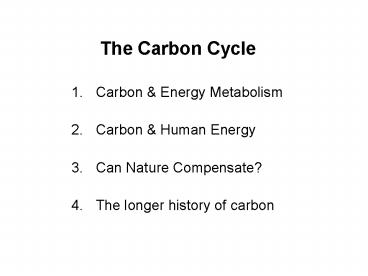The Carbon Cycle PowerPoint PPT Presentation
1 / 31
Title: The Carbon Cycle
1
The Carbon Cycle
- Carbon Energy Metabolism
- Carbon Human Energy
- Can Nature Compensate?
- The longer history of carbon
2
1. CARBON ENERGY METABOLISM
- (CH2O)n O2 CO2 H2O
aerobic respiration
autotrophic photosynthesis
Inorganic carbon source (autotrophs)
3
The Carbon Cycle
Energy Metabolism
respiration
photosynthesis
4
- Equilibrium
- equal balance between any powers, influences, etc
- What have fossil fuel emissions done to carbon
equilibria in the atmosphere?
5
- 2. CARBON HUMAN ENERGY
- Respiration releases the most CO2 to the
atmosphere. - What recent developments release lots of CO2 to
the atmosphere?
6
Fossil fuel consumption finishes what nature left
undone millions of years ago
respiration
Not broken down by respiration
7
Carbon Human Energy(Hansen et al. 2000)
8
(No Transcript)
9
US net carbon flux via land use changes 1700-2000
Here?
- What does the overall trend show? (petagrams/yr
1015 g)
Pre-1945 27 6 pg released Post-1945 2 2 pg
sequestered
What is happening here?
10
Numbers are x1015 g
11
NET CHANGE INPUT OUTPUT INTERNAL CHANGE
3.2 (110 6.3 1.6) (-111 -1.7) (0)
3.2 5.2
3.2 ? 5.2, so the equation is missing 2 billion
tons of carbon each year.
12
- 3. CAN NATURE COMPENSATE FOR CO2?
- Greening Earth Society
- Organization composed of electric utilities
- Produced video The Greening of Planet Earth
- Rising CO2 levels will help to green the planet
- Carbon dioxide from fossil fuels will be
sequestered in plant biomass
13
- Photosynthesis
- 6 CO2 6 H2O C6H12O6 6 O2
- Note the carbon component
14
- Net Primary Production (NPP)
- photosynthesis, minus respiration by the
photosynthesizers (kg Carbon/m²/year ) - Gross Primary Production (GPP) ?
- Steady state ecosystem
- GPP balanced by total respiration
- C6H12O6 6 O2 -------- 6 CO2 6 H2O
15
Question What will happen to global NPP as
tundra is converted to taiga?
16
Table 1 Surface area by type of cover and total
(from Atjay et al. 1979 and De Vooys 1979).
Ecosystem Type Surface area (x 106 km2) NPP (Pg)
Forest 31 48.7
Woodland, grassland, and savanna 37 52.1
Deserts 30 3.1
Arctic-alpine 25 2.1
Cultivated land 16 15.0
Human area 2 0.4
Other terrestrial (chapparral, bogs, swamps, marshes) 6 10.7
Subtotal terrestrial 147 132.1
Lakes and streams 2 0.8
Marine 361 91.6
Subtotal aquatic 363 93.4
Total 510 224.5
Petagram 1015 grams
17
Will increased CO2 green the earth?
- a) Nutrients veg growth
- Loblolly pine exposed to 1.5x higher CO2
Oren R, et al., Soil fertility limits carbon
sequestration by forest ecosystems in a
CO2-enriched atmosphere, NATURE 411 469-472 (
2001) Schlesinger WH, et al., Limited carbon
storage in soil and litter of experimental forest
plots under increased atmospheric CO2 NATURE
411 466-469 (2001)
18
- Free Air Carbon Enrichment (Duke University)
19
- Results
- Pines initially grew 25 faster
- But, returned to normal growth after 3 years
- Very little excess carbon sequestered in the soil
litter - Growth rates increased 75 when nitrogen added.
- Conclusion
- Nutrients, not carbon, limit loblolly growth.
20
- b. Soil respiration
- CO2 enrichment causes
- i. Short-term growth in European trees
- ii. Increasing soil microbial respiration
- iii. Declining sequestration of root-derived
carbon in the soil - Implications?
Heath J. et al., Rising atmospheric CO2 reduces
sequestration of root-derived soil carbon.
Science 309 1711-1713 (2005)
21
- Other effects
- c) Alaskan white spruce growth is down due to
drought stress (Barber et al. Nature 405668) - d) Climate change increases El Ninos, which cause
droughts that lead to burning of tropical forests
(Science 28935)
22
- e) BUT, Rapid polar warming has promoted plant
growth - From 1846-1995, lake freezes in Northern
Hemisphere have diminished 12 days - (Magnuson et al. Science 289 1743)
- Eurasian growing season is 18 days longer than in
1981 (J. Geophys. Res.) - Satellite photos Northern Hemisphere vegetation
denser now than 20 yr. ago - (J. Geophys. Res.)
23
- NPP increased 7.1 in North America from
1982-1998 (based on satellite data)
Hicke et al Geophys Res Let 29 (2002)
24
- About 50 of our increased CO2 emissions are
being sequestered rather than accumulating in the
atmosphere. - This rate is expected to diminish as warming
reduces the capacity of ecosystems to sequester
carbon.
25
- Compensation Puchlines
- 1. Increased NPP is occurring in northern polar
regions and North America - 2. In some areas / ecosystems it is limited by
nutrients and countered by drought fire. - 3. Increased growth has not been a sink for all
CO2
26
Mauna Loa atmospheric CO2 concentrations
Why the sawtooth?
27
- 4. WHAT IS THE LONGER HISTORY OF CARBON?
28
CO2 estimated using isotopic markers from marine
algae note big drop about 30 Mya
Fig. from Stoll, Nature 441579
29
Even higher levels 450 Mya!
gt20X more CO2 than now
So, why worry?
Radiation of mammals
x present concen.
30
- Greg Retallack, U of O Why did atmospheric
carbon diminish at end of Devonian? Hypothesis - Development of large land plants
- Roots caused soil to weather
- Calcium and magnesium weathered from soil went to
oceans combined with dissolved sodium
bicarbonate to form insoluble compounds. - Oceans absorbed more carbon from atmosphere.
31
Image Carbon Cycle Project, http//kfrserver.natu
r.cuni.cz/globe/index.html

